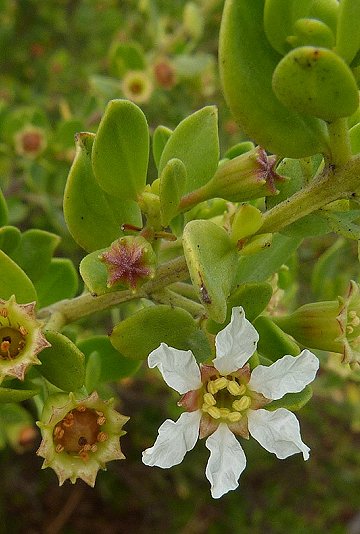
|
|
Pemphis (Pemphis acidula).
Leaves and flowers.
|
Pemphis - Pemphis acidula
Pemphis acidula, commonly known as bantigue (pron. bahn-TEE-geh) or mentigi, is a species of flowering plant in the family Lythraceae. It is a mangrove found throughout most of the tropical Indo-Pacific growing on rocky shores. The genus Pemphis, to which it belongs, was until recently thought to have only this single species, first described in 1775 and long considered the type species, but is now believed to have at least one other.
Pemphis acidula is an evergreen shrub or densely branching small tree usually growing from 0.6 - 8 metres tall, occasionally up to 11 metres. The bole is usually gnarled and much-branched. Occasionally the plant is a dwarf creeping shrublet only 15 cm high.
The leaves are succulent, pointed greyish-green, narrowly elliptic or lanceshaped, and are arranged opposite to each other on thick woody branches. Flattened hairs are found all over the leaves.
Flowers of Pemphis are small and cup-shaped having colours of white or pale pink. The flowers are usually found to bloom throughout the year. Fruits are small, reddish in colour containing around 20 seeds. The seeds burst open after ripening and are transported by wind and water and settle down. If favourable conditions are available, the seed germinates and sprout into a small plant.
Pemphis acidula is a halophyte bush found in coastal locations in the tropical areas of the Indo-Pacific. It is one of the types of shrubs growing in sandy and calcareous soils of the littoral zones of the Indian Ocean and the western and central Pacific Ocean. It is also found in mangroves.
Pemphis acidula (Shrubby
coral pemphis) is tropical and sub-tropical in distribution. It is also called as a
Digging sitck tree. In South Asia, this species is found in Indonesia, Japan, Philippines, Malaysia, Singapore, Sri Lanka, Viet Nam,
Thailand and India.
The tree is sometimes harvested from the wild for local use as a food, medicine and source of timber. The plant is sometimes grown as an ornamental - there is a significant trade in seeds and live plants, especially in Asia, for growing it as a bonsai.
The wood of this species has been traditionally valued in many cultures for it is hard and heavy, as well as resistant to rot and warping. It also has naturally a fine finish and may be fashioned into walking canes, fence posts, tool handles, and even anchors. In Réunion and Mauritius it is known as bois matelot. In the Maldives this hardy wood was used in traditional shipbuilding to hold the planks of the hull together, as well as to fashion "nails" in local sorcery.
Pemphis acidula is also one of the plant species used in bonsai. Due to its tropical preference and typhoon-resistance, it is the most common species for bonsai in the Philippines; but it is also grown as bonsai in Taiwan and the Ryukyu Islands of Japan. Due to its popularity and high value among bonsai enthusiasts, it is among the list of species classified as 'threatened' by the Department of Environment and Natural Resources of the Philippines. The collection, selling, and transport of wild Pemphis acidula is illegal in the Philippines and punishable by fines and imprisonment of up to six years.
In Marovo Island, Tonga, Tahiti, and other South Pacific islands, it is used to make wooden tools such as pestles, tool handles, weapons, and combs.
Edible Uses. The thick, fleshy leaves are used as a pot herb in Asia. The acid tasting leaves are eaten raw or boiled as a vegetable.
The fruits are sometimes eaten.
Medicinal. An infusion of the sap plus a handful of bark has been drunk as an abortifacient.
A filtered infusion of the bark is used as an abortifacient. The bark is used to treat stomatitis.
The bark contains 19 - 43% tannin. In-vitro tests of the bark showed an increased activity on the amplitude and frequency of uterine contractions, which confirms the traditional use in Vanuata as an abortifacient.
Source:
https://en.wikipedia.org/wiki/Sisal
https://pfaf.org/USER/Plant.aspx?LatinName=Agave+sisalana
https://www.britannica.com/plant/sisal
